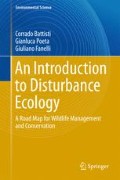Abstract
Disturbances of natural origin comprise many categories of processes: for example, fires, floods, extreme meteorological and marine events, water stress and other perturbations associated with hydrological dynamics, grazing, and predatory activities by consumer organisms at higher trophic levels. Moreover, they include all those events which can be connected to intra/and interspecific relations (Sousa 1984).
Access this chapter
Tax calculation will be finalised at checkout
Purchases are for personal use only
Notes
- 1.
Moreover, we refer you to the specific literature on natural disasters for the disturbances which damage human populations.
- 2.
As far as birds are concerned, there are many species on which fire exert positive effects because they are capable of colonizing newly burnt areas. For example, some species belonging to the order Piciformes which utilize necromass as trophic site, as well as ecotonal (edge) species (spotted flycatcher, Muscicapa striata, and other passerine birds of the family Sylvidae) and/or those species tied to the newly available resources (granivores, generalist omnivores; for Italy see also Ukmar et al. 2006). Since they can be easily sampled, birds are an extensively studied group of higher vertebrates.
References
Alexander DE (2001) Calamità naturali. Lineamenti di Geologia ambientale e studio dei disastri. Pitagora Editrice, Bologna
Ausden M (2004) Habitat management. In: Sutherland WJ, Newton I, Green RE (eds) Bird ecology and conservation. A handbook of techniques. Oxford University Press, Oxford, pp 329–369
Blondel J, Aronson J (1999) Biology and wildlife of the Mediterranean region. Oxford University Press, Oxford
Borghetti M, Giannini R (1998) Alterazioni della foresta. In: Provini A, Galassi S, Marchetti R (eds) Ecologia applicata. Cittàstudi, Torino, pp 487–503
Brawn JD, Robinson SK, Thompson FR III (2001) The role of disturbance in the ecology and conservation of birds. Ann Rev Ecol Syst 32:251–276
Cole DN (1994) The wilderness threat matrix: a framework for assessing impacts. Res. Pap. INT-475. Department of Agriculture, Forest Service, Intermountain Research Station, Ogden
Crandall RM, Hayes CR, Ackland EN (2003) Application of the intermediate disturbance hypothesis to flooding. Comm Ecol 4:225–232
Eldridge DJ, James AI (2009) Soil-disturbance by native animals plays a critical role in maintaining healthy Australian landscapes. Ecol Manag Restor 10:S27–S34
ESA (2000) Ecological principles for managing land use. Ecological Society of America
Hobbs RJ, Huenneke LF (1992) Disturbance, diversity, and invasion: implications for conservation. Conserv Biol 6:324–337
Hunter WC, Buehler DA, Canterbuty RA, Confer JL, Hannel PB (2001) Conservation of disturbance-dependent birds in eastern North America. Wildl Soc Bull 29:440–455
Junk WJ, Bayley PBB, Sparks RE (1989) The flood pulse concept in river-floodplain systems. Can Spec Publ Fish Aquat Sci 106:110–127
Lorimer CG (2001) Historical and ecological roles of disturbance in Eastern North American forests: 9000 years of change. Wildl Soc Bull 29:425–439
Mysterud A (2006) The concept of overgrazing and its role in management of large herbivores. Wildl Biol 12:129–141
Sousa WP (1984) The role of disturbance in natural communities. Ann Rev Ecol Syst 15:353–391
Spies TA, Hemstrom MA, Youngblood A, Hummel S (2006) Conserving old-growth forest diversity in disturbance-prone landscapes. Conserv Biol 20:351–362
Ukmar E, Battisti C, Luiselli L, Bologna MA (2006) The effect of fire on communities, guilds and species in burnt and control pinewoods in central Italy. Biodiv Conserv 16:3287–3300
Vannote RL, Minshall GW, Cummins KW, Sedell JR, Cushing CE (1980) The river continuum concept. Canad J Fish Aquatic Sc 37:130–137
Wiens JA (1989) The ecology of bird communities, vol 1, 2. Cambridge studies in ecology. Cambridge University Press, Cambridge
Author information
Authors and Affiliations
Corresponding author
Rights and permissions
Copyright information
© 2016 Springer International Publishing Switzerland
About this chapter
Cite this chapter
Battisti, C., Poeta, G., Fanelli, G. (2016). Categories of Natural Disturbances. In: An Introduction to Disturbance Ecology. Environmental Science and Engineering(). Springer, Cham. https://doi.org/10.1007/978-3-319-32476-0_7
Download citation
DOI: https://doi.org/10.1007/978-3-319-32476-0_7
Published:
Publisher Name: Springer, Cham
Print ISBN: 978-3-319-32475-3
Online ISBN: 978-3-319-32476-0
eBook Packages: Earth and Environmental ScienceEarth and Environmental Science (R0)

